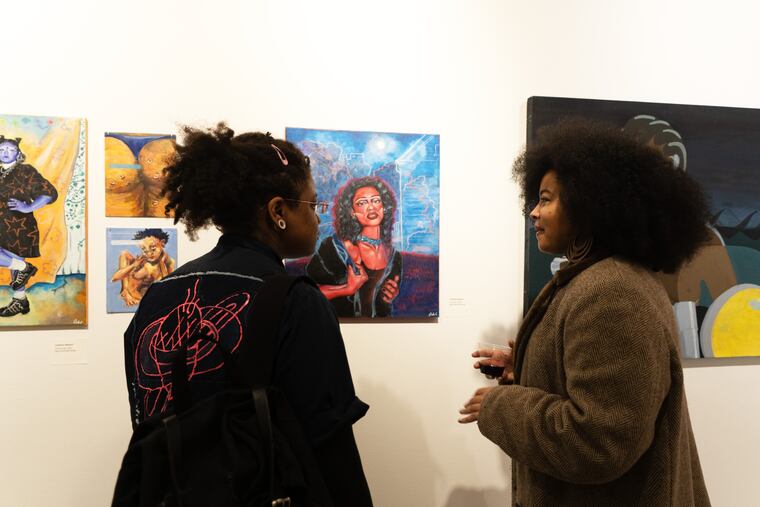A 1974 feminist art show gets a citywide, multi-venue blockbuster sequel
In the 1970s, women were not represented at all in the art world. The Philadelphia art show 'Focus' tried changing that.

No Mary Cassatt, no Frida Kahlo, no Faith Ringgold.
During the early 1970s, the situation for female artists in the United States was not unlike Gilead, the patriarchal state in Margaret Atwood’s novel The Handmaid’s Tale. In art history textbooks, women were not underrepresented; they were not represented at all. Equally discouraging, there were precious few women represented by galleries, in museums, or on art department faculties.
In January 1972, Diane Burko, a landscape painter and then recent graduate of Penn’s MFA program, attended the annual College Art Association in San Francisco. There, she encountered eminent art historians Ann Sutherland Harris and Linda Nochlin “bitching about zero women on the CAA board.” Their activism led to the creation of the Women’s Caucus for Art, an advocacy group for artists and historians.
That year, in April, in Washington, D.C., female artists convened a conference at the Corcoran Museum to protest the exclusion of female artists in the museum’s 1971 biennial. The attendees unanimously agreed: Things had to change.
Burko became a change agent when she returned to Philadelphia. After all, it was the home of the first women’s art school (now Moore College of Art, founded in 1848) and one of the first all-female art exhibitions (at the Women’s Pavilion of the Centennial Exposition in 1876). She invited artists and historians to discuss how to achieve what we call equity and inclusion today.
In the words of attendee Judith Stein, today a noted curator and author, they were “a posse of ... feminists determined to rebalance an off-kilter art world.” Also, there was Judith Brodsky, then an assistant printmaking professor at Beaver College (now Arcadia University). Burko and Brodsky wrote grants, asked banks for support, invited work from more than 80 contemporary artists, and encouraged area institutions to create their own exhibitions.
They titled the 1974 show “Philadelphia Focuses on Women in the Visual Arts” — “Focus” for short. It purveyed work by established artists such as Louise Bourgeois, Elaine de Kooning, Lee Krasner, Alice Neel, and Louise Nevelson next to Eleanor Antin, Barbara Chase-Riboud, Janet Fish, Yayoi Kusama, and Faith Ringgold. Grace Glueck, the New York Times art reporter, called it “one of the best group shows by artists of any gender recently seen on the East Coast art circuit.”
For the 50th anniversary of “Focus,” its initiators have made a blockbuster sequel. They are calling it “(Re)Focus,” and the citywide happening kicked off Jan. 27 at the Moore College of Art. It features the work of more than 400 women, nonbinary, and gender-nonconforming artists across 64 venues.
While the Moore show runs through March 16, most of the “(Re)Focus” exhibitions will continue at area galleries and venues through May and beyond. These include the African American Museum in Philadelphia, Art in City Hall, Asian Art Alliance, the Clay Studio, Fleisher Art Memorial, Pennsylvania Academy of the Fine Arts, Philadelphia Museum of Art, Taller Puertorriqueño, University of the Arts, and Woodmere Museum.
Moore’s “(Re)Focus” exhibition has two parts.
“ReFocus: Then” reconstructs the original 1974 show, pairing the work of each of the artists, many of whom have since died, with a photograph of her recent work. “ReFocus: Now,” organized by Moore’s gallery director Gabrielle Lavin Suzenski and Denise M. Brown, features works by nonbinary and gender-nonconforming artists like Wit Lopez, Eva Wu, and The Future is Us Collective.
“This new generation is taking the dream of diversity much further,” Brodsky said at a panel discussion that preceded the opening. On the panel were four artists from “(Re)Focus: Then”– Burko, Cynthia Carlson, Joyce Kozloff, and Barbara Zucker — and two — Lopez and Isa Isioma Matisse representing The Future is Us Collective — in “(Re)Focus: Now.” As each showed images of their work, everyone in the audience had a window seat in a time machine that took them from 1974 to the present. Walking through “(Re)Focus: Then” to “(Re)Focus: Now” makes that experience even more profound.
The exhibitions and programs scheduled at the participating local galleries, organizations, and institutions underscore a deeper understanding of the range of art by women and Philadelphia’s role in nurturing and educating so many of them.
Like Mary Cassatt, alumna of the Pennsylvania Academy of the Fine Arts (PAFA), subject of the exhibition “Mary Cassatt at Work” at the Philadelphia Museum of Art from May 18 through Sept. 8. And Anna Russell Jones, the first African American alumna of the Moore College of Art, celebrated in a retrospective at the African American Museum in Philadelphia from Jan. 31 to April 22. And Edna Andrade, PAFA alumna, whose “Space Dreams” is the February show at the Locks Gallery.
Information about “Refocus” exhibitions, events, films, and participating institutions can be found at www.refocus2024.org